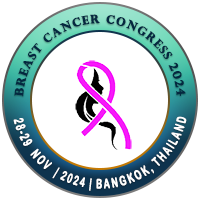
Angham T. Nawar Sr
King Abdulaziz University Hospital, Saudi ArabiaTitle: Increased Risk of Breast Fibroadenomas Among Obese and Postmenopausal Women With Uterine Fibroids
Abstract
Introduction
Uterine fibroids and breast fibroadenomas are common female benign neoplasms that are similarly derived from a single clonal origin and are modulated by estradiol concentration in blood. However, the association between these neoplasms has not yet been explored. Hence, this study aims to investigate the relationship between uterine fibroids and breast fibroadenomas.
Methods
A total of 199 women (cases: 72 women with uterine fibroids, control: 127 women without uterine fibroids) were included in this study. Ultrasound was used to screen for uterine fibroids, and both ultrasound and biopsy were utilized to diagnose breast fibroadenomas. Logistic regression analysis was used to investigate the association between uterine fibroids and breast fibroadenomas, and the factors associated with the relationship.
Results
Women with uterine fibroids have more than two times higher odds of having breast fibroadenomas among older women (p=0.03), more than twofold increased odds of breast fibroadenomas among obese females (p=0.05), and higher odds of having breast fibroadenomas among postmenopausal transition participant groups (OR=9.6; 95% CI 1.98-30.14; pvalue=0.005).
Conclusion
The association between uterine fibroids and breast fibroadenomas is significantly pronounced among older, obese, and postmenopausal women. This relationship might be driven by the indirect stimulation of estrogen hormone receptors via adipose tissue or other lifestyle as well as genetic factors. Therefore, further larger prospective studies considering these factors are needed to replicate the current findings.
Biography
To be updated soon.

